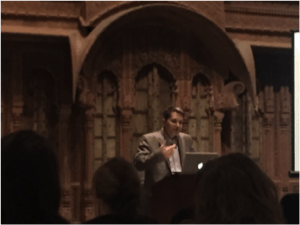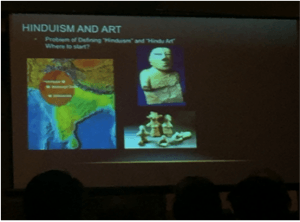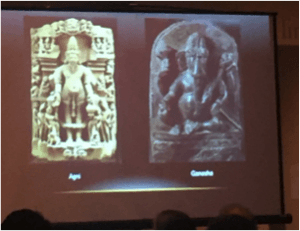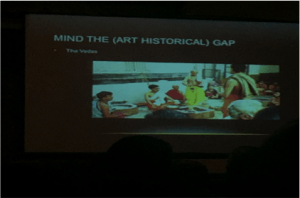Hindu Art has played an incredible role in India’s history. During the lecture Dr. Stephen Linduist gave at the Crow Museum, he englightened us about how Hindu Art has evolved over time and how it has become engrained in society in India. As he told us from the beginning, one of the key first questi on we have to ask ourselves when looking at this art is, “where did it come from?” We can learn so much about the art by just learning what sort of role it played in religion. So much of the art was in Hindu temples, or in entrances. Mythology played a key role in the evolution of Hindu Art. Much of the art was of their many gods, mainly Krishna, and Vishnu, and many of the earlier artifacts that have been found connect with Sanskrit texts. Today we see a lot of mythology in modern Hindu art as well: from sculptures of gods in homes to gods as popular comic book characters.
one of the key first questi on we have to ask ourselves when looking at this art is, “where did it come from?” We can learn so much about the art by just learning what sort of role it played in religion. So much of the art was in Hindu temples, or in entrances. Mythology played a key role in the evolution of Hindu Art. Much of the art was of their many gods, mainly Krishna, and Vishnu, and many of the earlier artifacts that have been found connect with Sanskrit texts. Today we see a lot of mythology in modern Hindu art as well: from sculptures of gods in homes to gods as popular comic book characters.
Yet when studying Hindu art, scholars still have a hard time of finding out where to start. There is no central institution in Hinduism, as there are in almost every other major religion. There are no central religious texts, only collections that are either created or passed down over generations. Also, there is no historical founder. But, if we look at Hindu art in a timeline, we can start to paint a better picture of how it has progressed and changed over time.

From examining the art from the Indus Valley Civilization, we can see the beginnings of art showing mythological themes, symbols, or gods. Living in NW India, the hundreds of small communities that made up the Indus Valley Civilizaiton all shared a common culture, technology, possibly a language, and artisitic themes. Many of the artistic works that have been found here have gods that seem to be very similar to modern day Hindu gods. The issue with this is that after the death of Indus Valley, we don’t see any more Hindu gods in any art for almost a thousand years. We see plenty of written evidence (Vedas) but no physical artwork, because they were nomadic and didn’t have any use for burdensome sculptures. Nomadic cultures tend to not have any permanent art. These nomads only needed the Vedic texts, which they had memorized to do their religious rituals and sacrifices. Large permanent artwork requires a dedicated working class, with enough additional resources to allow for people to work on art rather than get or make food, build houses, etc.
Looking at a timeline we see that the Indus Valley lasted from 2500-1900 BCE (first urbanization), and the Vedic Period lasted from then until around 800 BCE. The nomadic existence of these people however lasted until around 500 BC. We must remember to “mind the (art historical) gap” and understand that no permanent art was being made at this time. After 500 BC time we begin seeing a second urbanization, and continued growth and expansion through various rulers. At this time, I ndia was seeing the rise of temple Hinduism, the type of Hinduism we see today. We see elaborate and beautiful temples built starting at this time. This is what people think about when they think about Hindu Art. There was a cluster of artifacts that were coming from around the same time, giving us a better idea of what was happening and ho
ndia was seeing the rise of temple Hinduism, the type of Hinduism we see today. We see elaborate and beautiful temples built starting at this time. This is what people think about when they think about Hindu Art. There was a cluster of artifacts that were coming from around the same time, giving us a better idea of what was happening and ho
w the world was coming together. We must remember that Hinduism is a cumulative religion; it respects its past, but also incorporates new ideas. One example Dr. Lindquist gave was of Agni and Ganesha (pictured above right). Agni, the god of fire, was an early god in the Hindu religion; Ganesha, the lord of the armies, is a newer diety that we see with its famous elephant head.
After we looked at a number of artifacts and their role/purpose in the Hindu religion, Dr. Lindquist left ended his lecture. His presentation was wonderful, and I really enjoyed how knowledgeable he was about all of the Hindu artifacts and their importance.


